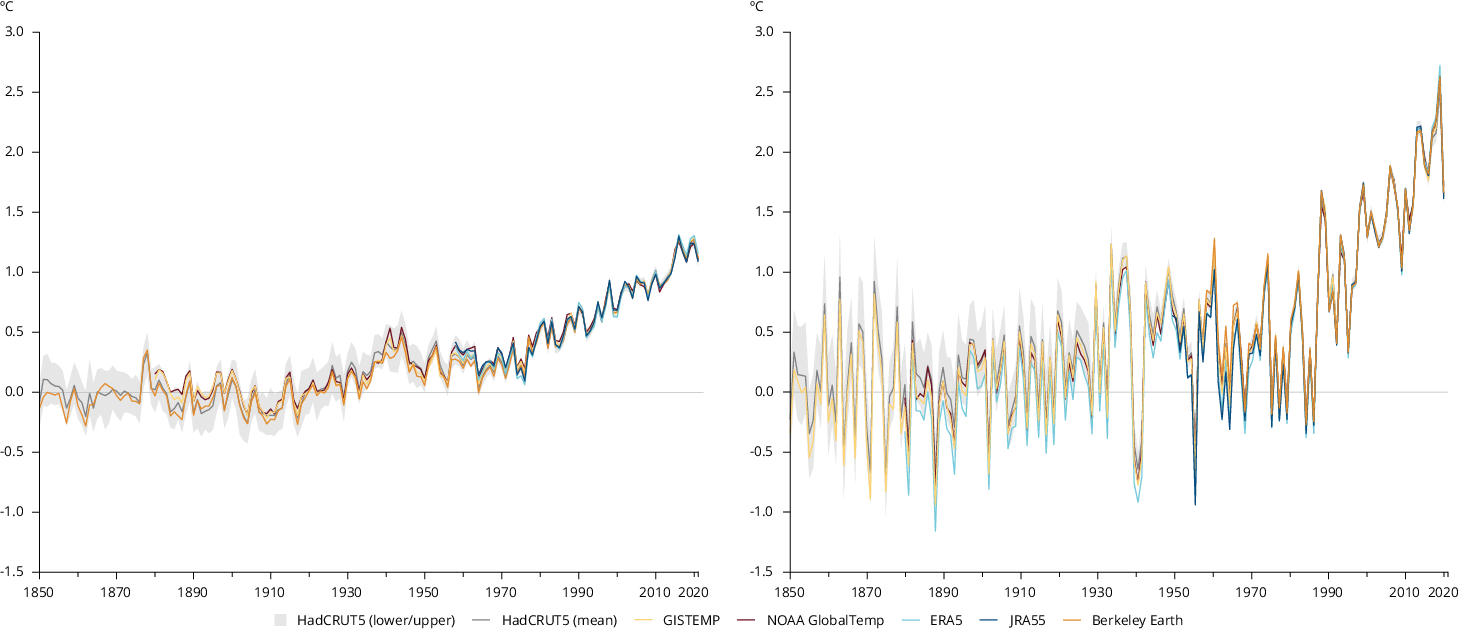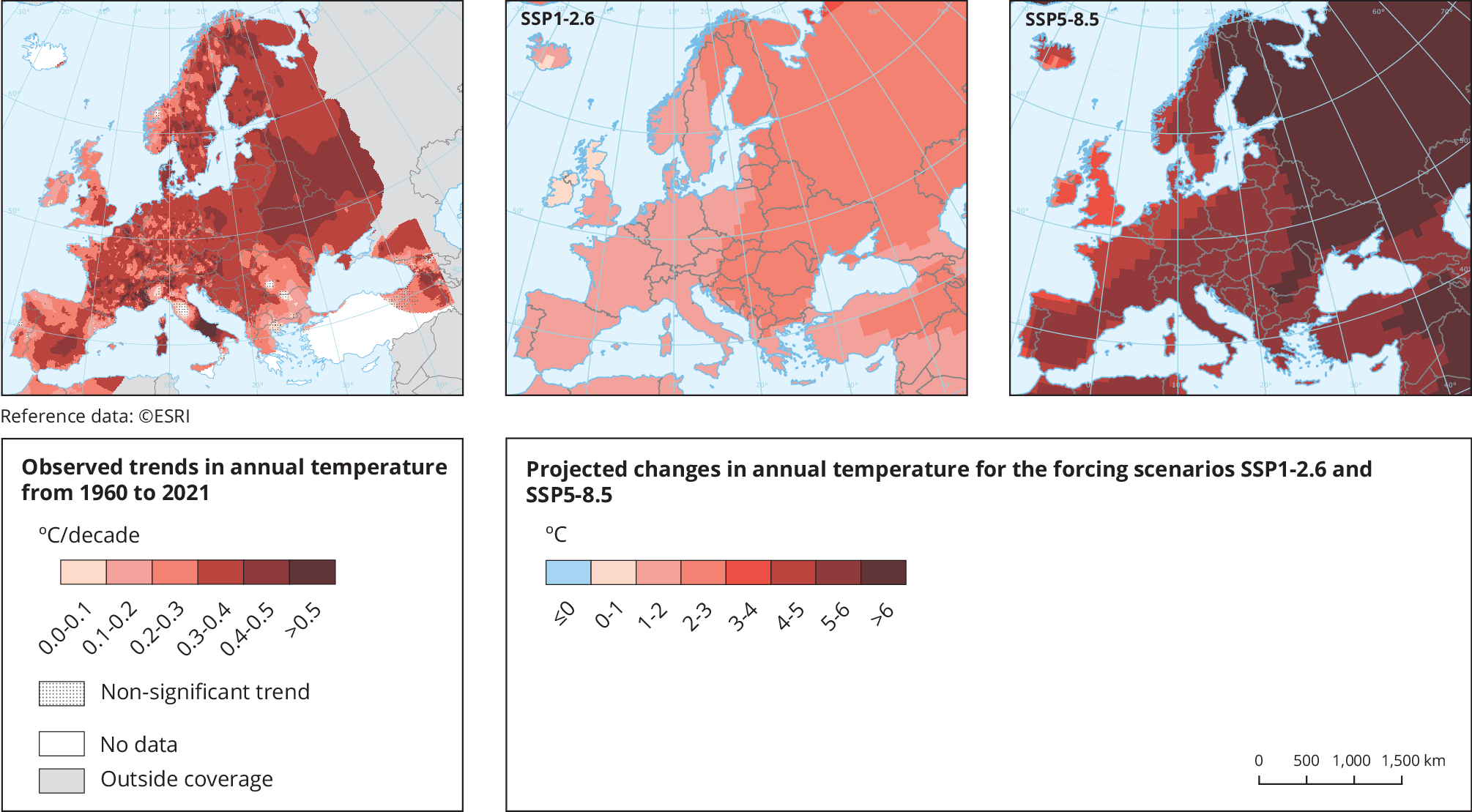2°C warming limit may be exceeded before 2050
2°C warming limit may be exceeded before 2050
Global mean near-surface temperature between 2012 and 2021 was 1.11 to 1.14°C warmer than the pre-industrial level, which makes it the warmest decade on record. European land temperatures have increased even faster over the same period by 1.94 to 1.99°C, depending on the dataset used.
The UNFCCC member countries have committed in the Paris Agreement to limiting global temperature increase to well below 2°C above the pre-industrial level and to aim to limit the increase to 1.5°C.
Without drastic cuts in global greenhouse gas emissions, even the 2°C limit will already be exceeded before 2050
European Environment Information and Observation Network (Eionet)

Trends in global temperature are an important indicator of the magnitude of climate change and its possible impacts. Global annual near surface temperature has been rising steadily since the end of the 19th century. The rate of increase has been particularly high since the 1970s at about 0.2°C per decade. In this period, global temperature has risen faster than in any other 50-year period over at least 2000 years, with the past 7 years (2015–2021) being the warmest on record. All temperature datasets used here place the year 2021 as one of the six warmest years on record, with anomaly ranges between 1.09°C and 1.16°C above pre-industrial levels. Anthropogenic activities, particularly greenhouse gas (GHG) emissions, are largely responsible for this warming.
To prevent serious environmental, economic and societal impacts of climate change, all signatories to the United Nations Framework Convention on Climate Change (UNFCCC) committed in the 2015 Paris Agreement to limiting global temperature increase to well below 2°C above pre-industrial levels by 2050 and to pursuing efforts to limit the increase to 1.5°C. The observed warming up to now already amounts to more than half of the maximum 2°C increase that would be compatible with the Paris Agreement.
Climate modelling has been used to estimate future climate change for different emissions scenarios and socio-economic pathways underlaying these scenarios (Shared Socioeconomic Pathways, SSP). Without significant efforts to curtail emissions, the increase in global temperature will continue rapidly, and even accelerate.
Global temperatures are projected to increase by 2.1-3.5°C above pre-industrial levels under SSP2-4.5 and by 3.3-5.7°C under SSP5-8.5 by the end of the 21st century. The only scenarios with a chance to stay within the limits established by the Paris Agreements are SSP1-1.9 with projected warming of 1.0–1.8°C and SSP1-2.6 with ranges between 1.3 to 2.4°C till the end of the 21st century compared to pre-industrial levels. These scenarios assume a drastic reduction in emissions in the coming decades and the decline of CO2 emissions to zero and subsequently negative net emissions around the year 2050 (scenario SSP1-1.9) or around 2080 (scenario SSP1-2.6).

Europe is warming faster than the global average. The mean annual temperature over European land areas in the last decade was 1.94 to 2.01°C warmer than during the pre-industrial period. The year 2020 was the warmest year in Europe since the instrumental records began according to all datasets used, with the range of anomaly between 2.51°C and 2.74°C above the pre-industrial levels. Particularly high warming has been observed over eastern Europe, Scandinavia and at eastern part of Iberian Peninsula.
Projections from the CMIP6 initiative suggest that temperatures across European land areas will continue to increase throughout this century at a higher rate than the global average. Land temperatures in Europe are projected to increase further by 1.2 to 3.4° under the SSP1-2.6 scenario and by 4.1 to 8.5°C under the SSP5-8.5 scenario (by 2071-2100, compared to 1981–2010). The highest level of warming is projected across north-eastern Europe, northern Scandinavia and inland areas of Mediterranean countries, while the lowest warming is expected in western Europe, especially in the United Kingdom, Ireland, western France, Benelux countries and Denmark.
References and footnotes
-
Masson-Delmotte, V., Zhai, P., Pirani, A., Connors, S. L., Péan, C., Berger, S., Caud, N., Chen, Y., Goldfarb, L., Gomis, M. I., Huang, M., Leitzell, K., Lonnoy, E., Matthews, J. B. R., Maycock, T. K., Waterfield, T., Yelekçi, Ö., Yu, R. and Zhou, B., eds., 2021, ‘Summary for policymakers’, in: Climate Change 2021: The Physical Science Basis. Contribution of Working Group I to the Sixth Assessment Report of the Intergovernmental Panel on Climate Change, Cambridge University Press.
-
WMO, 2022, ‘2021 one of the seven warmest years on record, WMO consolidated data shows’, (https://public.wmo.int/en/media/press-release/2021-one-of-seven-warmest-years-record-wmo-consolidated-data-shows) accessed May 17, 2022.
-
UNFCCC, 2016, ‘The Paris Agreement’, (http://unfccc.int/paris_agreement/items/9485.php) accessed January 4, 2017.
-
The range expresses the interval between the 5th and 95th percentile of territorial grid values.
-
Morice, C. P., Kennedy, J. J., Rayner, N. A., Winn, J. P., Hogan, E., Killick, R. E., Dunn, R. J. H., Osborn, T. J., Jones, P. D. and Simpson, I. R., 2021, ‘An Updated Assessment of Near-Surface Temperature Change From 1850: The HadCRUT5 Data Set’, Journal of Geophysical Research: Atmospheres 126(3), pp. e2019JD032361 (https://onlinelibrary.wiley.com/doi/abs/10.1029/2019JD032361) accessed December 14, 2021.
-
Karl, T. R., Arguez, A., Huang, B., Lawrimore, J. H., McMahon, J. R., Menne, M. J., Peterson, T. C., Vose, R. S. and Zhang, H.-M., 2015, ‘Possible artifacts of data biases in the recent global surface warming hiatus’, Science 348(6242), pp. 1469–1472 (http://www.sciencemag.org/content/348/6242/1469.abstract).
-
Zhang, H.-M., Lawrimore, J., Huang, B., Menne, M., Yin, X., Sanchez-Lugo, A., Gleason, B., Vose, R., Arndt, D., Rennie, J. and Williams, C., 2019, ‘Updated Temperature Data Give a Sharper View of Climate Trends’, Eos 100 (https://eos.org/science-updates/updated-temperature-data-give-a-sharper-view-of-climate-trends) accessed September 7, 2020.
-
Lenssen, N. J. L., Schmidt, G. A., Hansen, J. E., Menne, M. J., Persin, A., Ruedy, R. and Zyss, D., 2019, ‘Improvements in the GISTEMP Uncertainty Model’, Journal of Geophysical Research: Atmospheres 124(12), pp. 6307–6326 (https://onlinelibrary.wiley.com/doi/abs/10.1029/2018JD029522) accessed September 7, 2020.
-
UN, 2015, ‘Sendai Framework for Disaster Risk Reduction 2015 – 2030’, (http://www.preventionweb.net/files/43291_sendaiframeworkfordrren.pdf).
-
UN, 2015, Resolution adopted by the General Assembly on 25 September 2015: transforming our world: the 2030 agenda for sustainable development, A/RES/70/1
in EcoDebate, ISSN 2446-9394
A manutenção da revista eletrônica EcoDebate é possível graças ao apoio técnico e hospedagem da Porto Fácil.
[CC BY-NC-SA 3.0][ O conteúdo da EcoDebate pode ser copiado, reproduzido e/ou distribuído, desde que seja dado crédito ao autor, à EcoDebate com link e, se for o caso, à fonte primária da informação ]